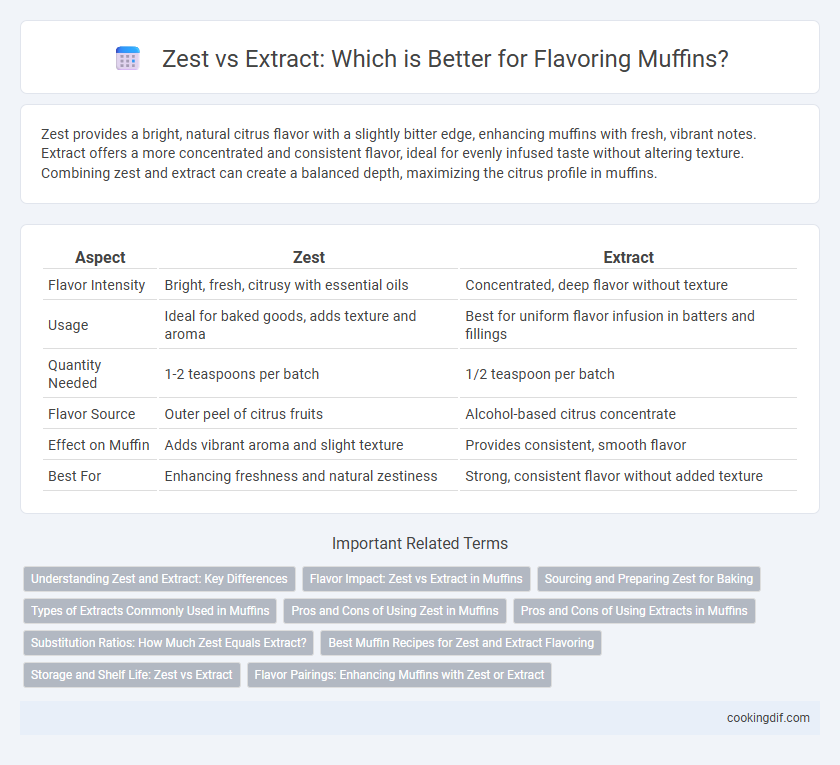Zest provides a bright, natural citrus flavor with a slightly bitter edge, enhancing muffins with fresh, vibrant notes. Extract offers a more concentrated and consistent flavor, ideal for evenly infused taste without altering texture. Combining zest and extract can create a balanced depth, maximizing the citrus profile in muffins.
Table of Comparison
| Aspect | Zest | Extract |
|---|---|---|
| Flavor Intensity | Bright, fresh, citrusy with essential oils | Concentrated, deep flavor without texture |
| Usage | Ideal for baked goods, adds texture and aroma | Best for uniform flavor infusion in batters and fillings |
| Quantity Needed | 1-2 teaspoons per batch | 1/2 teaspoon per batch |
| Flavor Source | Outer peel of citrus fruits | Alcohol-based citrus concentrate |
| Effect on Muffin | Adds vibrant aroma and slight texture | Provides consistent, smooth flavor |
| Best For | Enhancing freshness and natural zestiness | Strong, consistent flavor without added texture |
Understanding Zest and Extract: Key Differences
Zest is the outer colored skin of citrus fruits, containing essential oils that deliver a fresh, vibrant flavor and aroma to muffins, while extract is a concentrated liquid made by soaking ingredients like vanilla beans or citrus peels in alcohol, providing a more intense and consistent flavor. Zest adds texture and a natural brightness, enhancing the muffin's overall profile with subtle complexity, whereas extract infuses deep, uniform flavor without altering the batter's texture. Understanding these key differences helps bakers choose the right flavoring method to balance freshness and potency in muffin recipes.
Flavor Impact: Zest vs Extract in Muffins
Zest delivers a bright, intense citrus flavor in muffins by releasing essential oils from the fruit's outer peel, creating a fresh and aromatic taste profile. Extracts provide a more concentrated and consistent flavor, often with a sweeter, less complex aroma due to their alcohol-based composition. Using zest enhances the natural brightness and complexity of the muffin, while extract offers convenience and a pronounced but one-dimensional flavor impact.
Sourcing and Preparing Zest for Baking
Citrus zest for muffins is carefully sourced from organic lemons or oranges to avoid pesticide residues that can affect flavor and safety. The zest is prepared by using a microplane or fine grater to remove only the colorful outer layer, avoiding the bitter white pith underneath. Freshly grated zest releases essential oils that provide a more intense and aromatic flavor compared to bottled extracts, enhancing the muffin's overall taste profile.
Types of Extracts Commonly Used in Muffins
Vanilla extract is the most common type used in muffins, providing a rich, creamy flavor that enhances overall taste. Almond and lemon extracts are also popular choices; almond extract adds a nutty depth while lemon extract offers a bright, citrusy zest that complements fruit-based muffins. Clear or pure extracts derived from natural oils deliver a more intense flavor compared to artificial flavorings, making them preferable for gourmet muffin recipes.
Pros and Cons of Using Zest in Muffins
Zest in muffins offers a vibrant, natural citrus flavor with essential oils that provide a fresh aroma and enhance the overall taste profile without adding extra liquid. It can sometimes cause a slightly bitter note if overused, and the texture might introduce tiny, fibrous bits that contrast with the muffin's soft crumb. Using zest is ideal for those seeking a bright, authentic citrus essence, but precise quantity control is essential to avoid overpowering the batter or altering the texture negatively.
Pros and Cons of Using Extracts in Muffins
Using extracts in muffins offers concentrated flavor without altering the batter's consistency, providing convenience and ease of use. However, extracts can sometimes impart an artificial taste or bitterness if overused, potentially overpowering the subtle flavors in a muffin. The choice between zest and extract depends on desired flavor intensity and naturalness, with extracts excelling in shelf stability and uniformity but lacking the fresh, bright notes zest provides.
Substitution Ratios: How Much Zest Equals Extract?
When substituting zest for extract in muffin recipes, 1 tablespoon of lemon zest typically equals 1 teaspoon of lemon extract due to the intense flavor concentration in extracts. Zest provides a fresher, more natural citrus aroma, while extracts deliver a potent, consistent flavor; adjusting quantities accordingly is crucial to maintain balanced taste. Using too much zest can add bitterness, so precise substitution ratios ensure muffins achieve the desired flavor intensity without overpowering.
Best Muffin Recipes for Zest and Extract Flavoring
Zest provides a bright, fresh citrus aroma that enhances muffin recipes with natural oils from fruit peels, perfect for lemon or orange muffins. Extracts deliver concentrated, consistent flavor without added moisture, ideal for vanilla, almond, or chocolate muffins where precision is key. Combining zest and extract in muffin recipes maximizes depth and complexity, resulting in rich, flavorful baked goods.
Storage and Shelf Life: Zest vs Extract
Zest contains natural oils and moisture that can degrade quickly, resulting in a shorter shelf life of about one to two weeks when stored in the refrigerator. Extract, primarily composed of alcohol and flavor compounds, has a much longer shelf life, often lasting several years when kept in a cool, dark place. Proper storage of zest in airtight containers can slightly extend its freshness, but extract remains the superior option for long-term flavor preservation in muffins.
Flavor Pairings: Enhancing Muffins with Zest or Extract
Zest provides a bright, citrusy lift that enhances the natural fruit flavors in muffins, pairing exceptionally well with berries, vanilla, and almond. Extract offers a concentrated and consistent flavor, intensifying profiles like vanilla, almond, or lemon without adding moisture or texture changes. Using zest adds fresh, aromatic oils, while extract ensures a potent, uniform taste, allowing bakers to tailor flavor depth and complexity in muffins.
Zest vs Extract for flavoring Infographic

 cookingdif.com
cookingdif.com